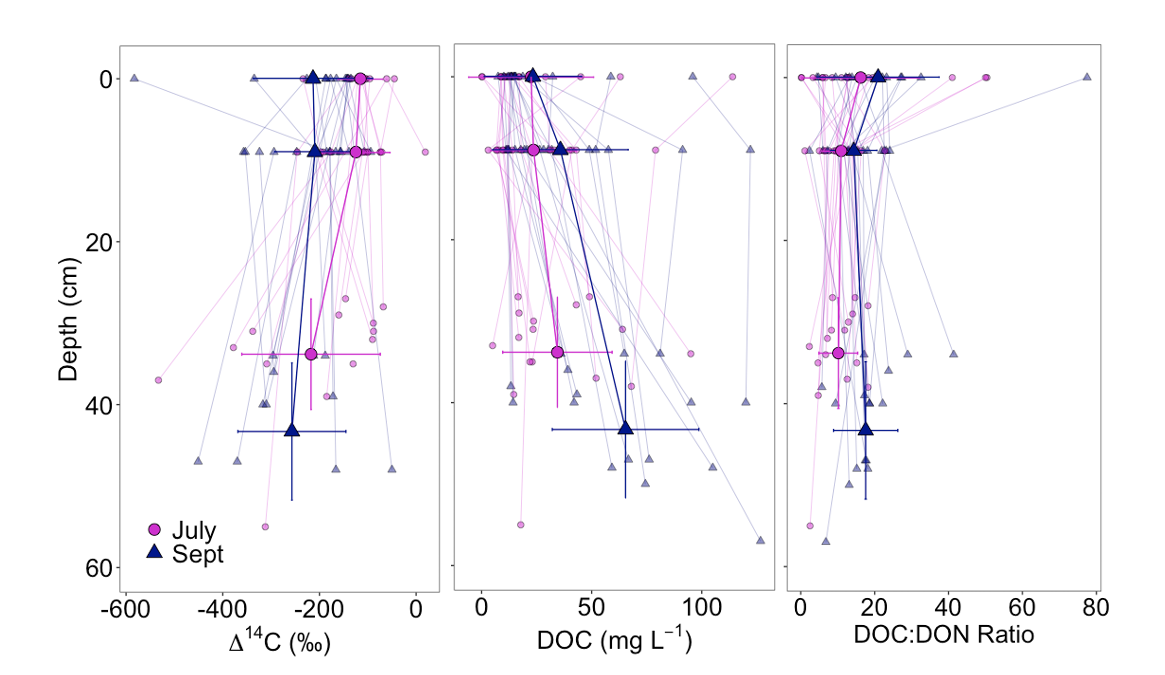February 28, 2022
Seasonal Permafrost Thaw Mobilizes Ancient and Labile Carbon
Age and chemistry of dissolved organic carbon reveal enhanced leaching of ancient labile carbon at the permafrost thaw zone.

Dissolved organic carbon Δ14C values (left), dissolved organic carbon concentration (center), and dissolved organic carbon to nitrogen ratio (right) of water from the surface, shallow subsurface, and the thaw table boundary in July (pink) and September (blue) 2013. Large points are means of the 17 drainages sampled.
[Reprinted under a Creative Commons Attribution 4.0 International License (CC BY 4.0) from McFarlane, K.J., et al. “Age and Chemistry of Dissolved Organic Carbon Reveal Enhanced Leaching of Ancient Labile Carbon at the Permafrost Thaw Zone.” Biogeosciences 19(4), 1211–1223 (2022). DOI: 10.5194/bg-19-1211-2022.]
The Science
Planetary warming is increasing the seasonal thaw of permafrost, making this extensive and old carbon stock vulnerable to loss back to the atmosphere. A research team assessed the age and chemistry of dissolved organic carbon in surface and soil pore waters that were collected between July and September 2013 from drainages in the vicinity of Utqiaġvik in northern Alaska. The amount and age of this carbon increased as the thaw layer deepened over the summer. Indicators of carbon source and lability suggested this carbon was derived from soil organic matter throughout the summer in 2013 and that this carbon may fuel microbial respiration that contributes to carbon emissions.
The Impact
Northern permafrost stores almost twice as much carbon as the atmosphere. Increased temperatures will make the extensive carbon stock vulnerable to decomposition and loss back to the atmosphere. This study illustrates the potential for increasing amounts of progressively older carbon to be mobilized with increasing permafrost thaw, which is expected with climate change. These findings also suggest a high potential for this carbon to contribute to greenhouse gas emissions as warming increases permafrost thaw.
Summary
The team sampled surface, shallow, and deep pore waters from 17 drainages in the Barrow Environmental Observatory near Utqiaġvik, Alaska in July and September 2013 to assess changes in age and chemistry of dissolved organic carbon over the summer. They used radiocarbon (14C) and assessment of organic matter composition with ultraviolet–visible spectroscopy to identify where and under what conditions old permafrost carbon is mobilized. Dissolved organic carbon age was highly variable, ranging from modern to approximately 7000 yBP. Over the summer, dissolved organic carbon age increased with depth as the active layer deepened, and with increasing drainage size. Dissolved organic carbon quality indicators did not differ with carbon age but reflected a carbon source rich in high molecular-weight and aromatic compounds, characteristics consistent with fresh vegetation that had not undergone extensive decomposition. In deep porewaters, dissolved organic carbon age was also correlated with several biogeochemical indicators (including dissolved methane concentration, δ13C, and the apparent fractionation factor), suggesting a coupling between carbon and redox biogeochemistry influencing methane production. In the drained, thawed lake basins included in this study, dissolved organic carbon concentrations and contributions of vegetation-derived organic matter declined with increasing basin age. The weak relationship between dissolved organic carbon age and chemistry and the consistency in chemical indicators over the summer in 2013 suggest a high biolability of old carbon released by thawing permafrost.
Principal Investigator
Karis McFarlane
Lawrence Livermore National Laboratory
mcfarlane3@llnl.gov
Program Manager
Daniel Stover
U.S. Department of Energy, Biological and Environmental Research (SC-33)
Environmental System Science
daniel.stover@science.doe.gov
Funding
This research is part of the Next-Generation Ecosystem Experiments—Arctic (NGEE—Arctic) project, which is supported by the Biological and Environmental Research Program within the Department of Energy’s (DOE) Office of Science (grant no. SCW1447).
References
McFarlane, K. J., et al. "Age and Chemistry of Dissolved Organic Carbon Reveal Enhanced Leaching of Ancient Labile Carbon at the Permafrost Thaw Zone." Biogeosciences 19 (4), 1211–1223 (2022). https://doi.org/10.5194/bg-19-1211-2022.

